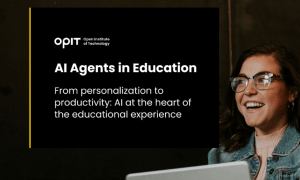

As we continue the slow march towards an AI-powered future, the coding and technical skills computer science graduates have are in increasingly high demand. This demand accounts for the high salary expectations of a computer science expert (the average salary in the field is €5,700 in Germany) and makes you more attractive as a hiring prospect to employers.
The challenge – finding a quality computer science course that provides the knowledge you need and has a reputation that forces employers to take notice. The four courses in this article (combined with related studies) transform you from computing enthusiast to sought-after computer scientist.
Top Free Computer Science Courses
Kicking off this computer science course list, we have a pair of the best free online computer science courses for building a foundation within the subject area.
Course 1 – CS50: Introduction to Computer Science (Harvard University)
If you’re looking for a free course that carries plenty of prestige, anything with the “Harvard” label attached is a good start. CS50 is a self-paced course, with Harvard estimating an 11-week completion time with between 10 and 20 hours of daily studying. It’s offered in English (sadly, no alternative languages exist at the time of writing) and it’s free to take, though you’ll pay $189 (approx. €175) for an official certificate.
The course covers programming language basics, starting with simple web-based HTML and advancing into Python and C. Advanced computing concepts, such as data structures and cybersecurity, are also covered, though you’re getting more of a baseline knowledge than specialized teaching. Think of the course as a computer science primer designed to give you a foundation that’s ideal for moving on to more complex studies. Add to that the Harvard seal of approval, which looks great on any CV, and you have a course that’s available globally and ideal for impressing employers.
Course 2 – CompTIA A+ (CompTIA)
This free course is A+ by name and mostly A+ by nature, with CompTIA advertising it as the perfect pathway to follow if you want a career in IT or computer sciences. You get an industry-recognized credential that employers will love, with the course focusing as much on practical skills (such as thinking on your feet in an IT crisis) as it does on theoretical instruction.
That’s not to say that theory isn’t covered. Once you’ve gotten to grips with the basics of the hardware and various operating systems, you’ll move into practical modules focused on networking, software, and cybersecurity. The course providers carry some industry weight, too, as titans like Dell, HP, and Intel recommend CompTIA’s courses for anybody who wants to break into the workforce.
There are some downsides – namely the minimal theoretical teaching makes it harder to understand why the practical things you’ll learn work. But as a companion piece to a more technical course (such as CS50), A+ is a great way to develop much-needed skills.
Other Notable Free Courses
The two courses listed above are far from the only free computer science course options available, with the following also being solid choices:
- Python for Everybody – Coming from the University of Michigan, this course teaches the ins and outs of a popular programming language used in AI and machine learning.
- IBM Data Science Professional Certificate – As something of a computer science-adjacent course, IBM’s certificate hones in on data science topics, such as visualization and machine learning models.
- Introduction to Computer Science and Programming – Put together by the best minds at the Massachusetts Institute of Technology (MIT), this is a great course for beginners who are starting from square one when it comes to programming.
Top Paid Computer Science Courses
If you have some money to spend on your education (or access to student funding) these are the best courses for computer science students who value a more traditional paid education.
Course 1 – Bachelor in Modern Computer Science (OPIT)
As an entirely online course, OPIT’s offering allows you to learn at mostly your own pace, though you’re still expected to complete coursework and pass exams at appropriate times. It’s a three-year course (though two-year fast-track options are available) and it’s provided by an institution that has European Qualification Framework (EQF) credentials.
Granted, the course doesn’t come cheap, with its €3,600 per year tuition fees adding up to €10,800 for a three-year course. But that money buys you a comprehensive computer science education, starting with the basics of software development before moving on to modern concepts, like AI and cloud computing. Along the way, you’ll earn professional certifications from Microsoft and Google, giving you something tangible to place on your CV even as you’re still studying. Credit transfer is also available for students who started a computer science course elsewhere and want to transfer to OPIT’s offering.
Course 2 – Computational Science and Engineering (Technical University of Munich)
Perpetually hovering around the top 50 universities in the world (it ranked 50th in 2021), the Technical University of Munich (TUM) is like the MIT of Europe. With this course, TUM offers something for students who’ve already started on the computer science track and now feel ready to bring those skills together with applied math and engineering for a Master’s certification.
Lasting four semesters of full-time study, the course costs €152.30 and delivers 120 ECTS credits. You’ll hone in on numerical simulation, focusing on how to develop math-based problem-solving methods that help in developing systems and simulations. Theory is king in this course. But you’ll come away with such a solid grounding in that theory (as well as experience with simulated applications) that prepare you for a computer science and engineering career.
Other Notable Paid Courses
More thought goes into choosing a paid computer science course because you’re investing more than just time into your studies. If neither of the above two courses whets your appetite, the following are a few other notable providers offering courses to European and international students:
- Computer Science BSc by Cambridge University – You get more than a degree from one of the UK’s most prestigious universities with this course. Given that Cambridge University lies in the heart of “Silicon Fen,” this course puts you in the ideal location to gain exposure to over 1,000 Cambridge-based tech companies.
- Computational Thinking for Problem Solving – Devised by the Penn University faculty, this four-week online course starts by teaching the “pillars” of computational thinking, ending with an applied task using the Python programming language.
- Computer Science 101L Master the Theory Behind Programming – Available via Udemy, this course costs about €69 or is available with a monthly subscription to Udemy. It features nearly 12 hours of recorded teaching sessions, alongside articles and other resources, that teach the basics of computer science.
Related Courses for a Well-Rounded Computer Science Education
The courses covered so far focus on computer science, with some variance in a few cases, which is like building the foundations for a house. To turn those foundations into something special (and something from which you can make a living), you may need a few more materials. Computer science-related courses give you those materials, with the following areas being great targets for further study.
Programming Languages
Programming is the beating heart of computer science. Every piece of software you’ll ever use has a program behind it. Most basic computer science courses teach general programming skills, often in Python, but further study into languages like SQL, Java, and C broadens your skillset to make you more attractive to employers.
Web Development
According to web3.career, the average European web developer picks up €70,000 per year, with potential to hit six figures with the right company and training. Many of the basics of web development are things you’ll pick up in a computer science course, though those looking for more formal certification should consider the following:
- Full-Stack Web Development for Free (CodingNinjas)
- Intro to HTML 5 (University of Michigan)
- Web Developer on Google Digital Garage (Google)
Cybersecurity
The European Council’s research suggests that the cost of cybercrimes amounted to €5.5 trillion on the continent alone, with ransomware attacks being among the biggest threats facing EU companies. Therein lies an opportunity – businesses don’t want to lose trillions of euros and your cybersecurity skills could be the shield they need to fend off cyberattacks.
Top cybersecurity courses to consider include:
- Google Cybersecurity (Google)
- The Complete Cyber Security Course (Udemy)
- Introduction to Cybersecurity Foundations (Infosec)
Data Science
Estimates state that the data science industry will have a 29% compound annual growth rate (CAGR) between 2022 and 2029, making it an ever-growing monolith in the computer science sector. Your ability to extract insights from massive datasets could be useful to employers and is buoyed by the following top courses:
- Data Science MicroMasters (University of California San Diego)
- CS109 Data Science (Harvard University)
- Master of Science in Machine Learning and Data Science (Imperial College London)
Tips for Choosing the Right Computer Science Course
The computer sciences courses covered in this article run the gamut from beginner-level programs to full Master’s degrees. If you feel like you’re struggling to navigate the sheer volume of options available, these tips help you pick an appropriate course:
- Be honest with yourself about your current skill level to choose a computer science course that challenges without being overwhelming.
- Compare the course’s curriculum and learning outcomes with your goals to ensure you’ll get what you need from your studies.
- Measure your time commitments (and how the course format allows for these commitments) against those the course demands.
- Research the instructors who created the course and check online reviews from past and current students.
- Determine whether the cost of the course (both monetary and time-wise) delivers a suitable return on your investment.
Start Your Computer Science Journey With the Right Course
Options abound when you’re looking for a computer science course, with quality free options sitting right alongside traditional paid courses. Whatever course you choose, always remember – one step in the right direction still means that you’re moving forward. By choosing a course, you take your first step into a constantly evolving and expanding world that could provide you with a lifelong career.
Related posts

Source:
- Times of Malta, published on September 18th, 2025
4 min read
The gathering brought together academics and technology leaders from prominent European Institutions, such as Instituto de Empresa (IE University), OPIT itself and the Royal College of Arts, to explore how artificial intelligence is reshaping the university experience.
The OPIT AI Copilot has been trained on the institute’s complete academic archive, a collection created over the past three years that includes 131 courses, more than 3,500 hours of recorded lectures, 7,500 study resources, 320 certified assessments, and thousands of exercises and original learning documents.
Unlike generic AI tools, the Copilot is deeply integrated with OPIT’s learning management system, allowing it to track each student’s progress and provide tailored support.
This integration means the assistant can reference relevant sources within the learning environment, adapt to the student’s stage of study, and ensure that unreleased course content remains inaccessible.
A mobile app is also scheduled for release this autumn, that will allow students to download exercise and access other tools.
During examinations, the Copilot automatically switches to what the institute calls an “anti-cheating mode”, restricting itself to general research support rather than providing direct answers.
For OPIT’s international community of 500 students from nearly 100 countries, many of whom balance studies with full-time work, the ability to access personalised assistance at any time of day is a key advantage.
“Eighty-five per cent of students are already using large language models in some way to study,” said OPIT founder and director Riccardo Ocleppo. “We wanted to go further by creating a solution tailored to our own community, reflecting the real experiences of remote learners and working professionals.”
Tool aims to cut correction time by 30%
The Copilot will also reduce administrative burdens for faculty. It can help grade assignments, generate new educational materials, and create rubrics that allow teachers to cut correction time by as much as 30 per cent.
According to OPIT, this will free up staff to dedicate more time to teaching and direct student engagement.
At the Milan event, Rector Francesco Profumo underlined the broader implications of AI in higher education. “We are in the midst of a deep transformation, where AI is no longer just a tool: it is an environment that radically changes how we learn, teach, and create,” he said.
“But it is not a shortcut. It is a cultural, ethical, and pedagogical challenge, and to meet it we must have the courage to rethink traditional models and build bridges between human and artificial intelligence.”
OPIT was joined on stage by representatives from other leading institutions, including Danielle Barrios O’Neill of the Royal College of Art, who spoke about the role of AI in art and creativity, and Francisco Machin of IE University, who discussed applications in business and management education.
OPIT student Asya Mantovani, also employed at a leading technology and consulting firm in Italy, gave a first-hand account of balancing professional life with online study.
The assistant has been in development for the past eight months, involving a team of OPIT professors, researchers, and engineers.
Ocleppo stressed that OPIT intends to make its AI innovations available beyond its own institution. “We want to put technology at the service of higher education,” he said.
“Our goal is to develop solutions not only for our own students, but also to share with global institutions eager to innovate the learning experience in a future that is approaching very quickly.”

From personalization to productivity: AI at the heart of the educational experience.
Click this link to read and download the e-book.
At its core, teaching is a simple endeavour. The experienced and learned pass on their knowledge and wisdom to new generations. Nothing has changed in that regard. What has changed is how new technologies emerge to facilitate that passing on of knowledge. The printing press, computers, the internet – all have transformed how educators teach and how students learn.
Artificial intelligence (AI) is the next game-changer in the educational space.
Specifically, AI agents have emerged as tools that utilize all of AI’s core strengths, such as data gathering and analysis, pattern identification, and information condensing. Those strengths have been refined, first into simple chatbots capable of providing answers, and now into agents capable of adapting how they learn and adjusting to the environment in which they’re placed. This adaptability, in particular, makes AI agents vital in the educational realm.
The reasons why are simple. AI agents can collect, analyse, and condense massive amounts of educational material across multiple subject areas. More importantly, they can deliver that information to students while observing how the students engage with the material presented. Those observations open the door for tweaks. An AI agent learns alongside their student. Only, the agent’s learning focuses on how it can adapt its delivery to account for a student’s strengths, weaknesses, interests, and existing knowledge.
Think of an AI agent like having a tutor – one who eschews set lesson plans in favour of an adaptive approach designed and tweaked constantly for each specific student.
In this eBook, the Open Institute of Technology (OPIT) will take you on a journey through the world of AI agents as they pertain to education. You will learn what these agents are, how they work, and what they’re capable of achieving in the educational sector. We also explore best practices and key approaches, focusing on how educators can use AI agents to the benefit of their students. Finally, we will discuss other AI tools that both complement and enhance an AI agent’s capabilities, ensuring you deliver the best possible educational experience to your students.
Have questions?
Visit our FAQ page or get in touch with us!
Write us at +39 335 576 0263
Get in touch at hello@opit.com
Talk to one of our Study Advisors
We are international
We can speak in:
